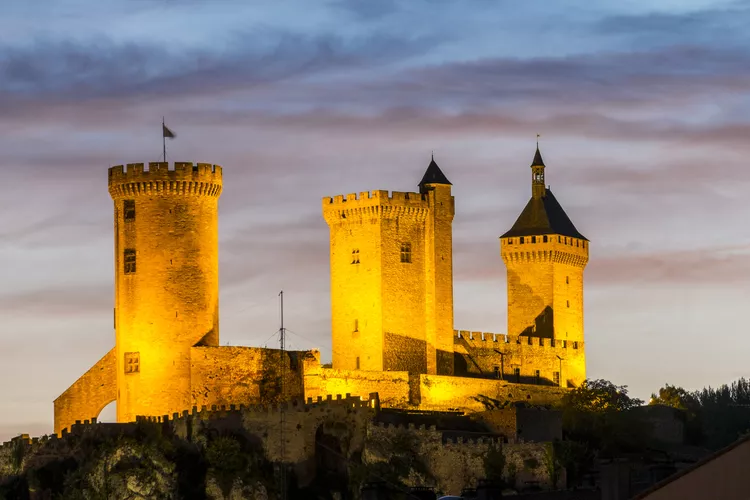Summary
A Small Mountain City With a Big Personality
Where is Foix?
Foix in the Ariège may be a small city, but it has a big personality. Surrounded by mountains and sliced with rivers, this is a true gateway to the glorious mountain range of the Pyrenees. Situated about 50 miles south of Toulouse and 40 miles from Andorra, it makes a good center for exploration of this part of southern France.
Spain and Andorra lie nearby to the south while the major cities and attractions of south-west France are close by. The popular Cathar country, with its splendid castles, are within reach. Moreover, the scenery here is nothing short of spectacular.
Foix is the smallest departmental capital in France. At the center of the picturesque Ariège, it is also in one of France’s least populous areas. A prime attraction of the territory is quite simply the vast diversity here and nearby. Either the Atlantic or Mediterranean coasts, while not mere minutes away by any stretch of the imagination, are within a reasonable distance.
Foix is placed between different worlds: the valley and one of the great mountain ranges of France, near the border with Spain, and between the eastern and the western Pyrenees. It has a diversity of rivers, streams, hills, mountains, caves, and hiking trails.
The Val d’Ariège
The Ariège river valley is the start of the Mediterranean zone. Rising in the high hills of the Pyrenees, it flows through Ax-les-Thermes down to the countryside north of Foix through a valley riddled with caves.
What to see in Foix
You can see the main feature of Foix from a long way away. Begun in the 10th century, the medieval castle dominates the city with its three hilltop towers, one square, one round, and the third topped with a conical roof, hinting at the power that the Counts of Foix once wielded. You can wander through the rooms, including the chamber of Henry IV who became King of France in the 16th century and climb the towers for the views over the surrounding countryside and the distant Pyrenees peaks.
The Old Town is a delightful maze of narrow streets of half-timbered houses dating from the 16th and 17th centuries.
Where to Stay
There are plenty of inexpensive hotels in Foix, though no outstanding or luxury options. Your best bet is the Hotel Lons, which is a quiet hotel near the river with a good restaurant. You can also check out other hotels in Foix to compare prices.
Camping du Lac is a wonderful lakefront, three-star site just a mile from the center of town. Tent sites are available, as are mobile home and caravan rentals. The site features a pool and tennis court.
Where to Eat
Try the restaurants and caves in the rue de la Faurie and the little surrounding streets where you’ll find a selection of auberges and bistros serving good local cooking. For French country cooking at a good value, eat at Le Jeu de l’Oie, 17 rue de la Faurie.
Where to Shop
Some of the best shopping comes at the local markets. Foix’s markets are held the first, third, and fifth Mondays of each month, and every Friday. The farmer and local artisan’s market is Tuesdays and Wednesdays, 9 a.m. to 7 p.m., from July through August.
Some nice ones to visit outside Foix include the Ax-les-Thermes market, held mid-June through mid-September on Tuesdays, Thursdays, and Saturdays from 8 am to 1 pm.
There are local markets in more villages around Foix; check them out here (in French).
A Fascinating History
Foix’s unique position—both in the remote countryside but close to crucial borders—has shaped its history and its architecture. It was originally created by the Romans who built a fort on the rocky hill where the castle stands. The city became a battleground for warring forces and factions: Aragon and Castille, Toulouse and Barcelona, England and France.
This part of France was always remote from the monarchs of northern France and became a hotbed for rebels against Catholicism.
In the 13th century, Simon de Montfort attacked the city between 1211 and 1217 during his crusade against the Cathars, based around Carcassonne. The Count of Foix, caught in the battles for succession, refused to recognize Philip the Bold as King of France whereupon the King, with the full fury of thwarted royalty, led an expedition against the city. The castle was besieged and the Counts abandoned the city. From the 16th century, the castle was used as a prison until 1864.
In 1589, the Count of Foix, Henry of Navarre, became King Henry IV of France, the first of the Bourbon Kings who lasted until the French Revolution ended the monarchy in France forever.
Getting Around Foix and the Ariège
If you plan to visit the Ariège, do yourself a big favor and rent a car. While you can get to the department by train, you won’t get around that way. Inner-departmental transportation is almost non-existent. The nearest airport is Toulouse, which is about a two-hour drive away from Foix.
Walking in and around Foix
Take a hike that blends history with activity. Follow the trail of Frenchmen, Jews, and downed World War II pilots along le Chemin de la Liberté. The challenging footpath was used by hundreds to escape occupied France and enter Spain.
Tourist office
Rue Theophile-Delcasse
Tel.: 00 33 (005 61 12 12
Website (in French)





